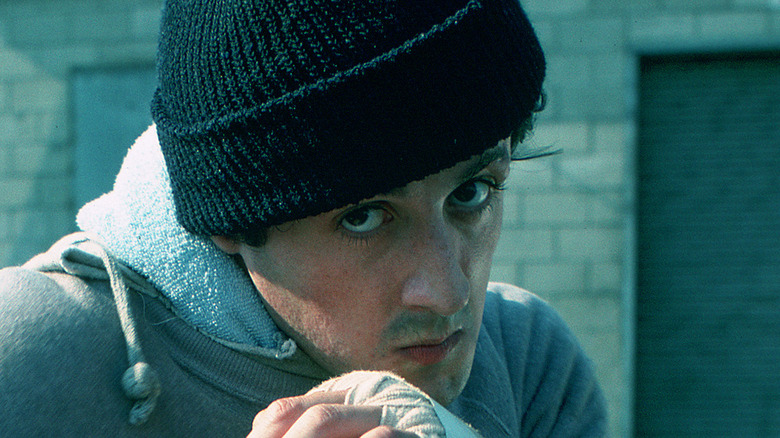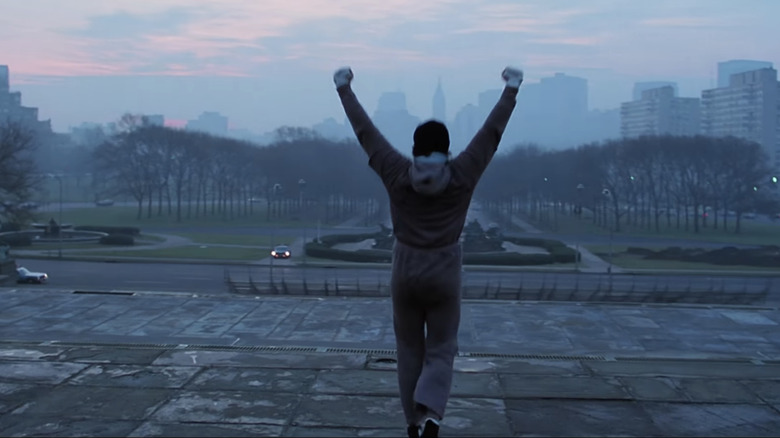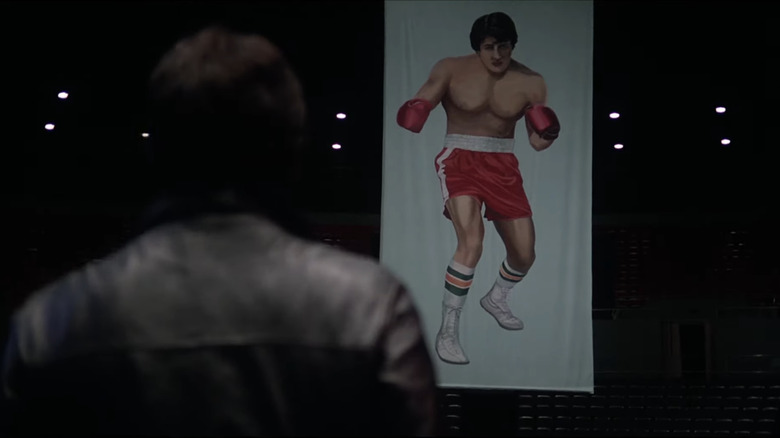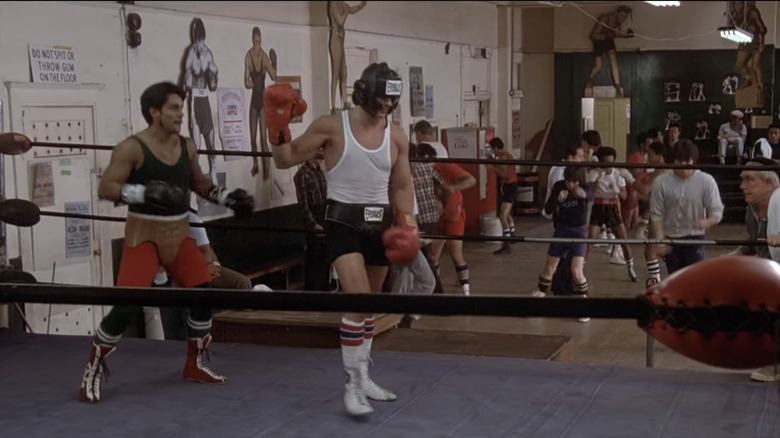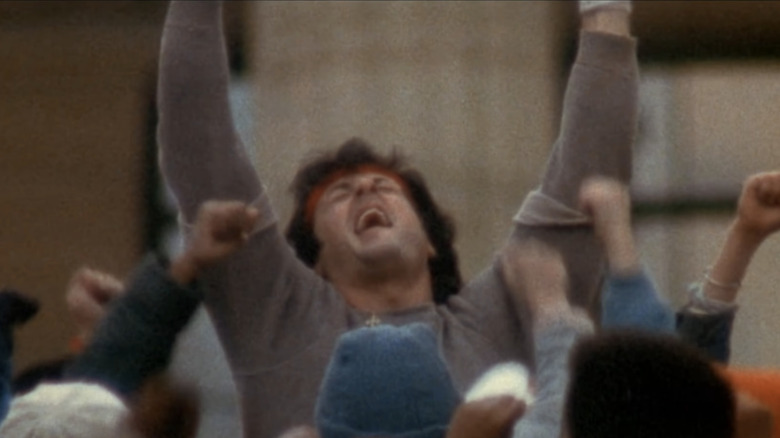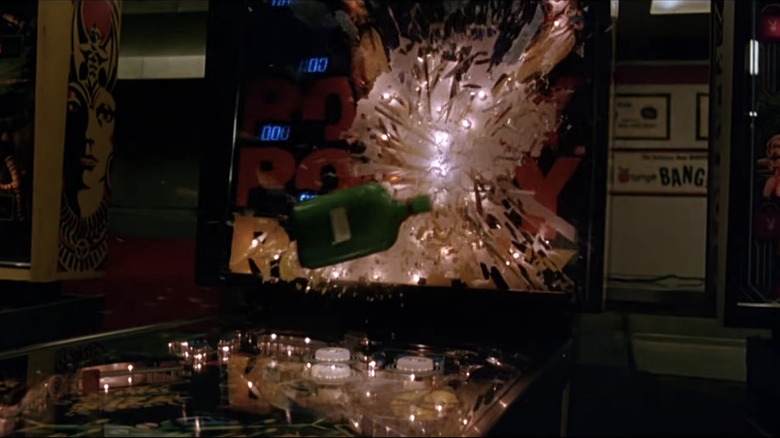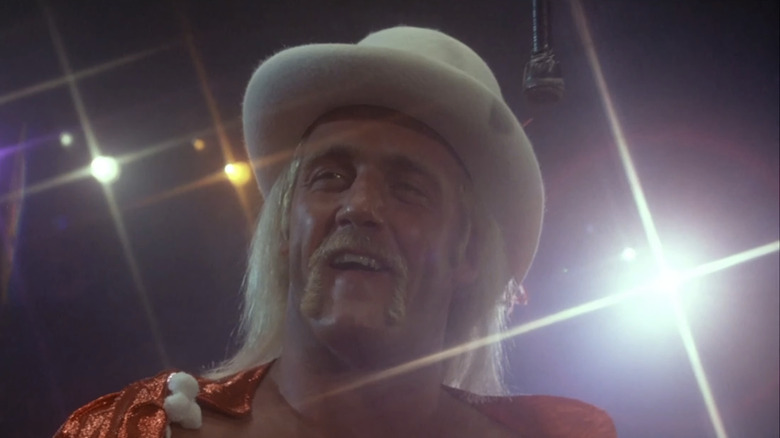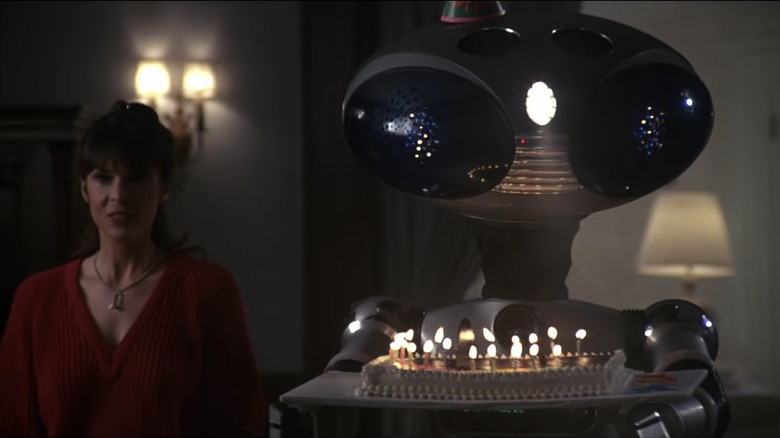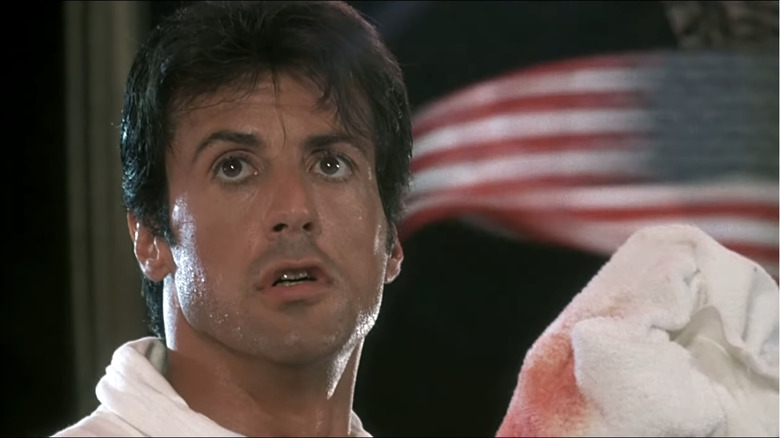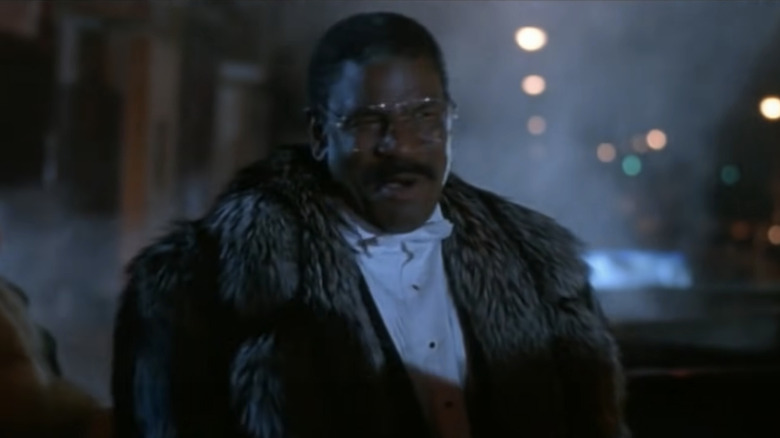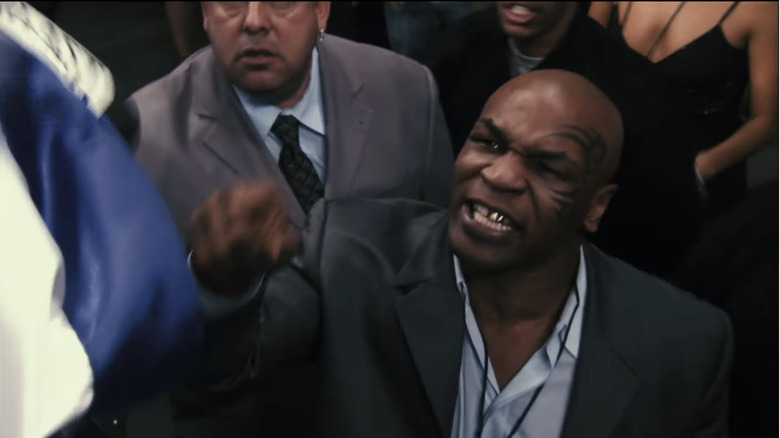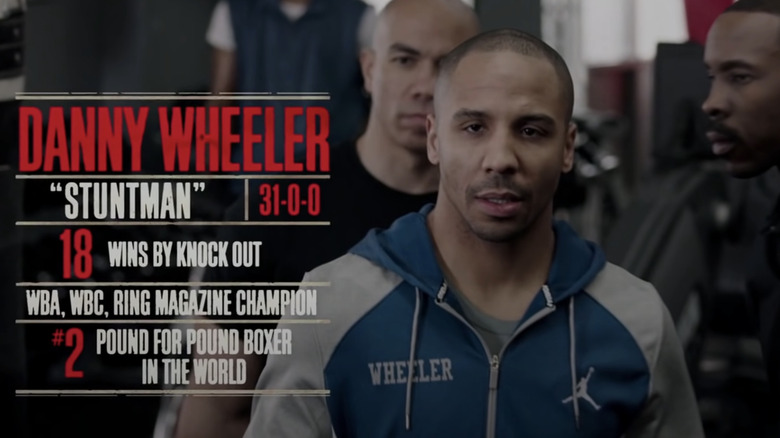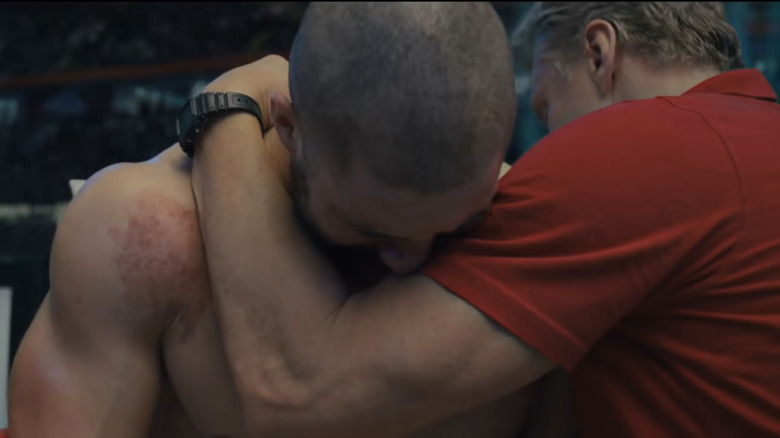The Most Pause-Worthy Moments In The Rocky Franchise
The "Rocky" franchise has had no shortage of memorable images, ever since writer-star Sylvester Stallone and director John G. Avildsen reinvented the training montage for modern audiences, punctuated by swelling music and an athlete triumphantly raising arms into the air.
Every sports movie since owes a little bit (or perhaps more) to the Stallone-fueled story of a punch-drunk club fighter who gets the shot of a lifetime. Stallone was a battler himself at the time; frustrated with an acting career that had mostly been bit roles, he wrote "Rocky" for himself — but when Hollywood came calling for the script, they wanted to give it to a star like Ryan O'Neal or James Caan. Stallone stayed true to his vision, insisting that the film couldn't be made without him in the boxing gloves — and the result is a series that has lasted 45 years and counting.
When the first film was released in 1976, it was seen as a sentimental throwback to the working class melodramas of the 1940s and '50s, but by the time "Rocky IV" came out in 1985, the franchise had reinvented itself for the MTV era, as sleek and up to date as Paulie's robot girlfriend. 30 years after that, it would reinvent itself once again for the reboot era with Ryan Coogler's "Creed," starring Michael B. Jordan as the son of Rocky's former opponent, dreaming of his own shot at glory. Here's a look back at just a handful of the most pause-worthy moments, whether iconic or subtle, in the "Rocky" franchise.
Gonna fly now
The first "Rocky" has earned such a reputation over the years as an uplifting crowd-pleaser that it can be jarring for first-time viewers when (spoiler alert) he loses the big fight against Muhammad Ali stand-in Apollo Creed (Carl Weathers) at the end of the film. Subsequent films in the series would make Rocky's victories more literal, but here, there is triumph is not in beating the heavyweight champion of the world, but simply making it into the ring and lasting all 15 rounds, something no one would have expected from him at the start of the film, where he's nothing but a 30-year-old palooka with a side gig collecting for the mob.
Rocky's personal victory is foreshadowed by a moment that's not only the film's most famous image, but one of the most famous images in film history: Rocky atop the massive steps of the Philadelphia Museum of Art, leaping in triumph with arms outstretched as Bill Conti's theme song "Gonna Fly Now" blasts on the soundtrack. It's an image that the series would return to many times over the years, and one that would-be Rockys still recreate. The moment comes at the end of a training montage, but what gives it power is how the montage begins, with Rocky trying and failing to run up the steps without getting winded. He returns to the steps a few more times before his final run, and his triumph comes not just from the act itself, but in Rocky's ability to persevere and accomplish what was once thought impossible.
The wrong colors
Rocky's climactic fight against Apollo Creed casts a long shadow, effectively dictating every mandatory "Rocky" film conclusion since, as well as not just how boxing matches are choreographed and directed in the movies, but arguably in real life as well.
Before that big scene, though, is a quieter moment between Rocky and Apollo's business manager Miles Jergens (Thayer David). Rocky stands alone in the empty stadium, staring up at a giant banner of himself hanging from the rafters. When he sees Jergens, he notes that the colors of his trunks on the banner are incorrect: red with a white stripe, instead of white with a red stripe. Jergens smiles. "It doesn't really matter, does it?"
It's a moment that reminds both Rocky and the audience that he is there to lose, that Creed offered the fight to him as a bicentennial gimmick, selling the idea of the American Dream like a carnival barker while uncaring about its actual feasibility. Rocky is a sacrificial lamb set up for slaughter, a Johnny Bravo who fits the suit; he wasn't even chosen for his skills in the ring, but for his nickname, "the Italian Stallion," which Apollo thought would help sell the fight by stoking racial tension. Avildsen captures both Rocky and his oversized avatar in the shot, emphasizing how surreal Rocky's experience is, how quickly he has gone from a nobody to a somebody, and how easily things are getting away from him.
Sparring with Duran
In between Rocky and 1979's "Rocky II," Stallone starred in two box office bombs: a wrestling pic called "Paradise Alley" and Norman Jewison's 1930s union drama "F.I.S.T." His return to the world of Rocky Balboa could be seen as a commercial decision, and as critic Matt Singer noted in 2013 for the defunct film site The Dissolve, that ambivalence can be felt in the sequel's story, which has Rocky squander the money he made from the Creed fight, fall back into collecting for his local loan shark, and agree to fight Creed again only when the champ demands a rematch.
Rocky is unmotivated to return to the ring, as seen in a brief moment at the gym alongside his cantankerous trainer Mickey (Burgess Meredith). Rocky spars with a smaller opponent while Mickey continually scolds him for being slow and to "catch that little squirt!" The little squirt in question is none other than boxing legend Roberto Durán, who at the time was the WBA and WBC World Lightweight champion. Durán has no lines and director Stallone (taking the reins for the rest of the series until "Rocky V") never gives the viewer a clear look at his face; even die-hard fans could be forgiven for missing the cameo.
Years later, Stallone would confirm that he and the champ really sparred during filming; when asked by TMZ in 2014 if he would ever spar with boxer Bernard Hopkins, who at the time had launched an impressive comeback at age 49, Stallone laughed and said, "I learned my lesson with Durán"."
Rocky's New Friends
Despite being the same length as the first film, "Rocky II" simply feels longer. Part of that is due to its shaggy plot, which begins immediately after the ending of "Rocky" and stretches across the next year and a half or so, leading up to the rematch with Creed.
"Rocky," along with "Jaws" and "Star Wars," was one of the first blockbusters to turn sequels into big business, and in "Rocky II" there's still a sense of feeling out exactly what a sequel to "Rocky" should be. It often plays like a remake of the first film, stretching credulity by putting Rocky back in Mickey's gym, mopping up spit and sweat, so that he can rise up from nothing once again.
But when it comes time to play the hits, "Rocky II" knows to go big. The first film's training montages and run up the steps of the Philadelphia Museum of Art were instantly iconic, and the City of Brotherly Love embraced both Rocky and the New York-born Stallone as their hometown hero. "Rocky II" gilds the lily by having Rocky (and Stallone) cheered on from every street corner as he does his morning road work, and when it comes time to once again leap up the 72 steps to the museum, he has been joined by seemingly every child in Philly. This time, there are no failed attempts to get up the steps before he finally makes it; this is a victory lap.
The Rocky pinball machine
When Balboa returned to the screen for 1982's "Rocky III," there was no false modesty, no need to start over from scratch. After beating Apollo Creed in their rematch at the end of "Rocky II," Rocky goes on an impressive run, successfully defending his title and becoming a rich and famous celebrity in the process. The scene in "Rocky II" where he bombs a commercial taping due to his lack of camera presence and inability to read the cue cards is forgotten here; now, he's the charming face of American Express. Not everyone is so happy with his reign, however; as Rocky becomes successful beyond his wildest dreams, up-and-coming heavyweight Clubber Lang (Mr. T) watches from the crowd, waiting for his chance to knock Rocky from his perch.
Someone else is also resentful of the new champ: his roughneck brother-in-law Paulie (Burt Young), who throughout the series is frequently a pathetic figure, alternately idolizing and despising Rocky for achieving everything he never could. One night in a drunken stupor, Paulie wanders into an arcade and sees a Rocky-branded pinball machine. Incensed, he throws his liquor bottle at the game and shatters the backglass display, exposing the machinery working underneath and foreshadowing Rocky's internal struggle as he seeks to regain the championship after losing to Lang.
The machine was created for the film by Gottlieb Amusement Games and mass produced as a promotional tie-in, albeit with a different background than the one Paulie smashed, perhaps to deter copycats.
Rocky vs. Thunderlips
Early on in "Rocky III," Balboa participates in a strange charity exhibition bout with professional wrestler Thunderlips, played by a pre-"Hulkamania" Hulk Hogan.
The logistics of the fight don't make a lot of sense. Rocky wears boxing gloves and is apparently fighting according to the rules of his sport, while Thunderlips is free to kick and grapple and throw Rocky out of the ring at will. Perhaps even more confusing, this is supposed to be a "real" fight, despite the fact that Thunderlips is clearly a WWE-style pro wrestler, with all the theatrics, choreography (and "fake" theatricality) that implies. In the film's version of kayfabe, the wrestling code of silence, all of Thunderlips' moves are real, and Rocky wins the day by knocking him unconscious.
The fight may be fake, but what's very real is the significant height difference between Rocky and Thunderlips. Stallone is famously sensitive about his height, claiming over the years to be just shy of five-foot-eleven, even as co-stars and former romantic partners peg his true height at several inches less. Hogan's height is similarly subject for debate, and Stallone often films him at a lower angle in order to emphasize his fearsomeness. But in the shots of the two actors framed together, it's clear that Hogan towers over Stallone in a way that shines a suspicious light on that five-foot-eleven claim.
Paulie's robot girlfriend
As much as the "Rocky" films have changed over the years, Stallone's writing and performance of the title character have remained remarkably consistent. Though the circumstances of "Rocky IV" put him in grim avenger mode for much of the film, Rocky remains, at heart, an endearingly silly man. He has pet turtles named Cuff and Link, and when Adrian gives birth he tells her what a great job she did, as if their son was an impressive dinner. Rocky is also notably terrible with money; after getting paid for his first fight with Apollo, he immediately buys a motorcycle and silk-printed jacket with a tiger on the back.
That mix of childlike silliness and imprudence finds its greatest expression in the bulbous-headed robot servant Rocky and the family give Paulie for his birthday in "Rocky IV." Appearing from the shadows like a creature from a horror movie and bearing a cake in its arms, the robot terrifies Paulie at first. But as soon as he figures out how to have it speak in a woman's voice, it quickly becomes the most important thing in Adrian's brother's life — and perhaps, the most memorable thing about "Rocky IV."
In real life, the International Robotics creation — nicknamed SICO – was designed as an educational aid for special needs children and became something of a celebrity in the 1980s, thanks in large part to its appearance in the film. "Rocky" peripherals can have a strange shelf life, as evidenced by the infamous "The Meat" action figure; it's no surprise, then, that Stallone's decision to cut SICO out of his 2020 director's cut proved controversial.
Creed vs. Drago
The Rocky-Thunderlips bout, in which a fun exhibition match turns unexpectedly serious, is given a dark reprise in "Rocky IV" when Apollo Creed comes out of retirement to fight Soviet giant Ivan Drago (Dolph Lundgren). Drago and his team, including wife Ludmilla (Brigitte Nielsen, Stallone's real-life partner at the time) and government handler Koloff (Michael Pataki) initially call out Rocky to fight in a goodwill East-meets-West exhibition match, but it's Apollo, in the throes of a midlife crisis, who accepts the challenge.
The fight is broadcast on television, with real life commentator Stu Nahan and referee Lou Fillipo playing themselves. Apollo surrounds the stoic Russian with a full Las Vegas revue complete with James Brown singing his latter-day hit "Living in America." Rocky and trainer Duke (Tony Burton), decked out in Hugo Boss sweatsuits, are his corner men. It's all fun and games — that is, until the fight begins.
When it becomes clear that Apollo is no match for Drago, who fights with murderous precision, Rocky and Duke want to throw in the towel, but Creed's pride — the same pride that put him in the ring with Drago in the first place — won't let them. Director Stallone films Apollo's death like a woozy nightmare, full of slow motion shots of Creed's horrified wife (Sylvia Meals), Ludmilla's devilish grin as he falls, and the bloody white towel, tossed a moment too late. The scene obviously propels the rest of the film, as Rocky seeks vengeance against Drago in Russia, but it's also key to the later plots of the "Creed" films.
Duke gets KO'd
The first attempt to reboot the "Rocky" series wasn't "Creed" or even 2006's "Rocky Balboa," but in many ways 1990's "Rocky V."
Bringing back director Avildsen, "Rocky V" is an intentional step back from the excesses of previous entries, putting Rocky back in the old Philly neighborhood after a crooked accountant steals his money and the threat of permanent brain damage puts an end to his boxing career. Taking over Mickey's old gym, Rocky trains promising young fighter Tommy "Machine" Gunn (Tommy Morrison, grandson of John Wayne). But when Tommy comes under the sway of duplicitous promoter George Duke (Richard Gant), Rocky's former student becomes his adversary.
The Duke character is clearly based on promoter Don King, who had become a pop culture fixture in the 1980s thanks to his flamboyant work in service of heavyweight champ Mike Tyson. A former numbers runner for the Cleveland mob who got into the fight game after a stint in jail for manslaughter, King's wild hair, flashy clothes, and constant swindling of his clients (including Tyson, Muhammad Ali, and Evander Holyfield) made him both despised and begrudgingly admired.
Plenty of people have wanted to knock King to the ground over the years, and "Rocky V" gives viewers the next best thing. After beating Tommy in a street brawl, Rocky advances on George Duke. "You touch me, I'll sue," Duke sneers. Rocky hesitates, then socks him so hard in the gut that he goes airborne and lands on the hood of his limousine, to the cheers of the gathered crowd.
Iron Mike sitting ringside
It's kind of amazing that Mike Tyson and Rocky Balboa never crossed paths prior to 2006's "Rocky Balboa." Both men were arguably the biggest names in boxing in the 1980s, at least for the general public. Clubber Lang's viciousness in the ring is fairly similar to Tyson's, but that's mostly a coincidence; when "Rocky III" came out in 1982, Tyson was still an unknown. His biggest years in the ring coincided with the first hibernation of the "Rocky" series between 1985 and 1990, and in the series' second hibernation, from 1990 to 2006, Tyson went from heavyweight champ to convicted rapist to an ear-biting pariah. After losing to Lennox Lewis in 2002, his career slouched along for a few years before coming to an undignified end in 2005.
Still, there were few names more synonymous with championship boxing than Tyson's, and Stallone gives him a prominent cameo at the film's climactic fight. After an ESPN computer simulation has Rocky (in his prime) beating current heavyweight champ Mason "the Line" Dixon (real-life fighter Antonio Tarver), Dixon's team harangues Rocky into stepping back into the ring for an exhibition match. Filmed during a real life championship match and called by HBO Boxing's actual commentators, the fight attempts a more realistic tone than some of the series' previous fights, including having Dixon get into a shouting match with Tyson, who is sitting ringside.
Tales of the Tape
Nine years after "Rocky Balboa" seemingly put a cap on the series, writer-director Ryan Coogler brought it back to roaring life with "Creed," which follows Adonis Johnson (Michael B. Jordan), the illegitimate son Apollo Creed never knew he had, enlisting Rocky's help to become a champion boxer. The film earned Stallone his first Oscar nomination for acting since the original "Rocky" and gave Coogler and Jordan their blockbuster breakthrough; three years later, they would shake up the Marvel Cinematic Universe together in 2018's "Black Panther."
Adonis' journey takes him from a cushy Los Angeles upbringing by Apollo's widow (Phylicia Rashad, stepping in for Sylvia Meals) to the still-mean streets of Philly. Local musician Bianca (fellow MCU star Tessa Thompson) teaches him about cheesesteaks and the many definitions of "jawn," while his "uncle" Rocky becomes a sometimes fraught stand-in for the father he never knew. Coogler makes an effort to show off the real Philadelphia with a documentary-like focus on the tactile feelings of the city, much as Avildsen did 35 years earlier. He also throws in a few stylistic flourishes, casting real boxers like Andre Ward and Tony Bellew as Adonis' fictional opponents and flashing their stats up on screen in the style of old boxing posters, connecting the past and present of the sport, just as the film connects the past and present of the franchise.
Ivan Throws in the Towel
One of the most impressive things about "Creed" is how Coogler could have easily ignored any or all of the sequels, just as other reboots like "Superman Returns" had done, but instead embraces a playbook similar to "Cobra Kai," embracing and honoring the sequels with perhaps as much affection as the original film. The result was an affecting, serious drama built upon the backstory of arguably the silliest installment, "Rocky IV."
Apollo's death and Rocky's guilt at having not done more to save his friend come to the fore once again in "Creed II," directed by Steven Caple Jr. The film repeats and condenses Rocky's journey from his second, third, and fourth films, as Adonis (now an established champion) frets over Bianca's difficult pregnancy, experiences a brutal defeat at the hands of Ivan Drago's son Viktor (Florian Munteanu), and returns to California to find his own "eye of the tiger" and take his revenge.
Fatherhood is the major theme of "Creed II," especially the responsibility of fathers to their children. Rocky's lingering guilt is misinterpreted by Adonis as a lack of confidence in his abilities and creates a rift between them; meanwhile, Ivan has clearly been training Viktor for this moment his entire life, but when it finally comes, the experience is bitter. In the film's final fight, Adonis is close to beating Viktor to death, just as Ivan had done to Adonis' father three decades earlier. And just like Rocky on that fateful night, Ivan now has the choice of whether to throw in the towel or let the fight continue. But unlike Rocky, Ivan chooses love over glory; he throws in the towel, and saves his son's life.
